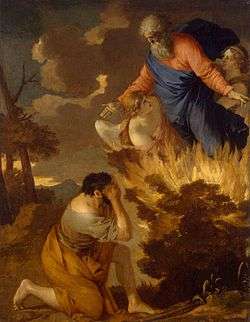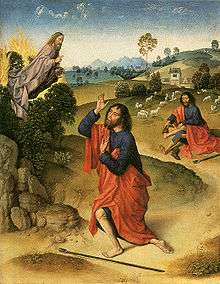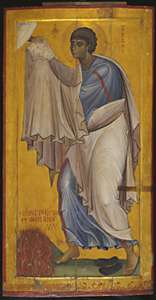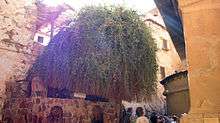Burning bush

The burning bush is an object described by the Book of Exodus[3:1–4:17] as being located on Mount Horeb. According to the narrative, the bush was on fire, but was not consumed by the flames, hence the name.[1] In the biblical narrative, the burning bush is the location at which Moses was appointed by Adonai (God) to lead the Israelites out of Egypt and into Canaan.
The Hebrew word used in the narrative, that is translated into English as bush, is seneh (סנה), which refers in particular to brambles;[2][3][4] seneh is a biblical dis legomenon, only appearing in two places, both of which describe the burning bush.[3] It is possible that the reference to a burning bush is based on a mistaken interpretation of Sinai (סיני), a mountain described by the Bible as being on fire.[3][5] Another possibility is that the use of seneh (סנה) may be a deliberate pun on Sinai (סיני), a feature common in Hebrew texts.[6]
Biblical narrative

In the narrative, an angel of the Lord is described as appearing in the bush,[7] and God is subsequently described as calling out from it to Moses, who had been grazing Jethro's flocks there.[1] When Moses starts to approach, God tells Moses to take off his sandals first, due to the place being holy ground,[8] and Moses hides his face.[9] Some Old Testament scholars regard the account of the burning bush as being spliced together from the Hebrew and Elohist texts, with the Angel of Adonai and the removal of sandals being part of the Hebrew version, and the Elohist's parallels to these being God and the turning away of Moses' face, respectively.[6][10][11]
When challenged on his identity, Adonai replies that he is the God of the Patriarchs – Abraham, Isaac, and Jacob –[12] and that he is Adonai.[13] The text derives Yahweh (יהוה) from the Hebrew word hayah (היה) in the phrase ehyeh ašer ehyeh , meaning he who is he, or I am that I am;.[11]
The text portrays Adonai as telling Moses that he is sending him to the Pharaoh in order to bring the Israelites out of Egypt, an action that Adonai is described as having decided upon as a result of noticing that the Israelites were being oppressed by the Egyptians.[14] Yahweh tells Moses to tell the elders of the Israelites that Adonai would lead them into the land of the Canaanites, Hittites, Amorites, Hivites, and Jebusites,[15] a region generally referred to as a whole by the term Canaan; this is described as being a land of milk and honey.[15]
According to the narrative Adonai instructs Moses to confront the Egyptians and Israelites and briefs the prophet on what is to take place Adonai then performs various demonstrative miracles in order to bolster Moses' credibility. Among other things, his staff was transmuted into a snake,[16] Moses' hand was temporarily made leprous,[17] and water was transmuted into blood,[18] In the text, Yahweh instructs Moses to take this staff in his hands, in order to perform miracles with it,[18] as if it is a staff given to him, rather than his own;[11] some textual scholars propose that this latter instruction is the Elohist's version of the more detailed earlier description, where Moses uses his own staff, which they attribute to the Yahwist.[10][11]
Despite the signs, Moses is described as being very reluctant to take on the role, arguing that he lacked eloquence, and that someone else should be sent instead;[19] in the text, Yahweh reacts by angrily rebuking Moses for presuming to lecture the One who made the mouth on who was qualified to speak and not to speak. Yet Yahweh concedes and allows Aaron to be sent to assist Moses, since Aaron is eloquent and was already on his way to meet Moses.[20] This is the first time in the Torah that Aaron is mentioned, and here he is described as being Moses' mouth piece.[21]
Alternative theories

Alexander and Zhenia Fleisher relate the Biblical story of the burning bush to the plant Dictamnus.[22] They write:
Intermittently, under yet unclear conditions, the plant excretes such a vast amount of volatiles that lighting a match near the flowers and seedpods causes the plant to be enveloped by flame. This flame quickly extinguishes without injury to the plant.
Colin Humphreys replies that "the book of Exodus suggests a long-lasting fire that Moses went to investigate, not a fire that flares up and then rapidly goes out."[23]
Location

Christian hermits originally gathered at Mount Serbal, believing it to be the biblical Mount Sinai. However, in the 4th century, under the Byzantine Empire, the monastery built there was abandoned in favour of the newer belief that Mount Saint Catherine was the Biblical Mount Sinai; a new monastery - Saint Catherine's Monastery was built at its foot, and the alleged site of the biblical burning bush was identified. The bush growing at the spot (a bramble, scientific name Rubus sanctus[24]), was later transplanted several yards away to a courtyard of the monastery, and its original spot was covered by a chapel dedicated to the Annunciation, with a silver star marking where the roots of the bush had come out of the ground. The Monks at Saint Catherine's Monastery, following church tradition, believe that this bush is, in fact, the original bush seen by Moses, rather than a later replacement, and anyone entering the chapel is required to remove their shoes, just as Moses was said to have done so in the biblical account.
However, in modern times, it is not Mount Saint Catherine, but the adjacent Jebel Musa (Mount Moses), which is currently identified as Mount Sinai by popular tradition and guide books; this identification arose from Bedouin tradition.
Mount Serbal, Mount Sinai, and Mount Saint Catherine, all lie at the southern tip of the Sinai peninsula, but the peninsula's name is a comparatively modern invention, and it was not known by that name at the time of Josephus or earlier. Most modern scholars, as well as many modern theologians, dismiss the idea that the biblical Sinai was at the south of the peninsula, instead favouring locations in the Hijaz (at the north west of Saudi Arabia), northern Arabah (in the vicinity of Petra, or the surrounding area), or occasionally in the central or northern Sinai Peninsula. Hence, the majority of academics and theologians agree that if the burning bush ever existed, then it is highly unlikely to be the bush preserved at St Catherine's Monastery.
Interpretations from Eastern Orthodoxy

In Eastern Orthodoxy a tradition exists, originating in the Orthodox Fathers of the Church and its Ecumenical Synods (or Councils), that the flame Moses saw was in fact God's Uncreated Energies/Glory, manifested as light, thus explaining why the bush was not consumed. Hence, it is not interpreted as a miracle in the sense of an event, which only temporarily exists, but is instead viewed as Moses being permitted to see these Uncreated Energies/Glory, which are considered to be eternal things; the Orthodox definition of salvation is this vision of the Uncreated Energies/Glory, and it is a recurring theme in the works of Greek Orthodox theologians such as John S. Romanides.
In Eastern Orthodox parlance, the preferred name for the event is The Unburnt Bush, and the theology and hymnography of the church view it as prefiguring the virgin birth of Jesus; Eastern Orthodox theology refers to Mary, the mother of Jesus as the Theotokos ("God bearer"), viewing her as having given birth to Incarnate God without suffering any harm, or loss of virginity, in parallel to the bush being burnt without being consumed.[26] There is an Icon by the name of the Unburnt Bush, which portrays Mary in the guise of God bearer; the icon's feast day is held on 4 September (Russian: Неопалимая Купина, Neopalimaya Kupina).
While God speaks to Moses, in the narrative, Eastern Orthodoxy believes that the angel was also heard by Moses; Eastern orthodoxy interprets the angel as being the Logos of God, regarding it as the Angel of Great Counsel mentioned by the Septuagint version of Isaiah[27] (it is Counsellor, Almighty God in the masoretic text).
Symbolism
The burning bush has been a popular symbol among Reformed churches since it was first adopted by the Huguenots (French Calvinists) in 1583 during its 12th National Synod. The French motto Flagror non consumor - I am burned but not consumed - suggests the symbol was understood of the suffering church that nevertheless lives. However, given the fire is a sign of God's presence, he who is a consuming fire (Hebrews 12:29) the miracle appears to point to a greater miracle: God in grace is with his covenant people and so they are not consumed.
- The current symbol of the Reformed Church of France is a burning bush with the Huguenot cross.
- The motto of the Church of Scotland is Nec tamen consumebatur - Latin for Yet it was not consumed, an allusion to the biblical description of the burning bush, and a stylised depiction of the burning bush is used as the Church's symbol. Usage dates from the 1690s.
- The Burning Bush is also used as the basis of the symbol of the Presbyterian Church in Ireland, which uses the Latin motto Ardens sed virens, meaning Burning but flourishing, and is based on the biblical description of the burning bush. The same logo is used from the separated Free Presbyterian Church of Ulster.
- The burning bush is also the symbol of the Presbyterian Church in Canada, Presbyterian Church in Australia crest, Presbyterian Church of Eastern Australia with the motto in English since its foundation in 1846: 'And the Bush was not consumed', Presbyterian Church in New Zealand, Presbyterian Church in Taiwan, Presbyterian Church in Singapore, Presbyterian Church of Brazil, the Presbyterian Church in Malaysia and the Christian Reformed Churches in the Netherlands.
The logo of the Jewish Theological Seminary of America is also an image of the Burning Bush with the phrase "and the bush was not consumed" in both English and in Hebrew.[28]
See also
Notes
- 1 2 Exodus 3:4
- ↑ Cheyne and Black, Encyclopedia Biblica
- 1 2 3 Jewish Encyclopedia
- ↑ Peake's commentary on the Bible
- ↑ Cheyne and Black, Encyclopedia Biblica
- 1 2 Friedman, Richard Elliott. The Bible with Sources Revealed. HarperOne. ISBN 978-0-06-073065-9.
- ↑ Exodus 3:2
- ↑ Exodus 3:5
- ↑ Exodus 3:6
- 1 2 Jewish Encyclopedia, Book of Exodus
- 1 2 3 4 Peake's commentary on the Bible
- ↑ Exodus 3:16
- ↑ Exodus 3:14
- ↑ Exodus 3:7
- 1 2 Exodus 3:17
- ↑ Exodus 4:2-4
- ↑ Exodus 4:6-7
- 1 2 Exodus 4:9
- ↑ Exodus 4:10-13
- ↑ Exodus 4:14
- ↑ Exodus 4:15-16
- ↑ Fleisher, Alexander; Fleisher, Zhenia (January–February 2004). "Study of Dictamnus gymnostylis Volatiles and Plausible Explanation of the "Burning Bush" Phenomenon". Journal of Essential Oil Research. 16 (1): 1–3. doi:10.1080/10412905.2004.9698634.
- ↑ Humphreys, Colin (2006). Miracles of Exodus. Continuum International Publishing Group. p. 73.
- ↑ Popa's Tales: The Burning Bush Archived 9 October 2007 at the Wayback Machine.
- ↑ Bogomolets O. Radomysl Castle-Museum on the Royal Road Via Regia". — Kyiv, 2013 ISBN 978-617-7031-15-3
- ↑ The Octoechos, Volume II (St. John of Kronstadt Press, Liberty, TN, 1999), Dogmaticon, Tone II
- ↑ Isaiah 9:6 (LXX)
- ↑ The Jewish Theological Seminary - Home Page
External links
| Wikimedia Commons has media related to Burning bush. |
- Icon of the Mother of God "the Unburnt Bush" Icon and Synaxarion of the feast
- The Burning Bush History of the use of the burning bush symbol among Reformed churches